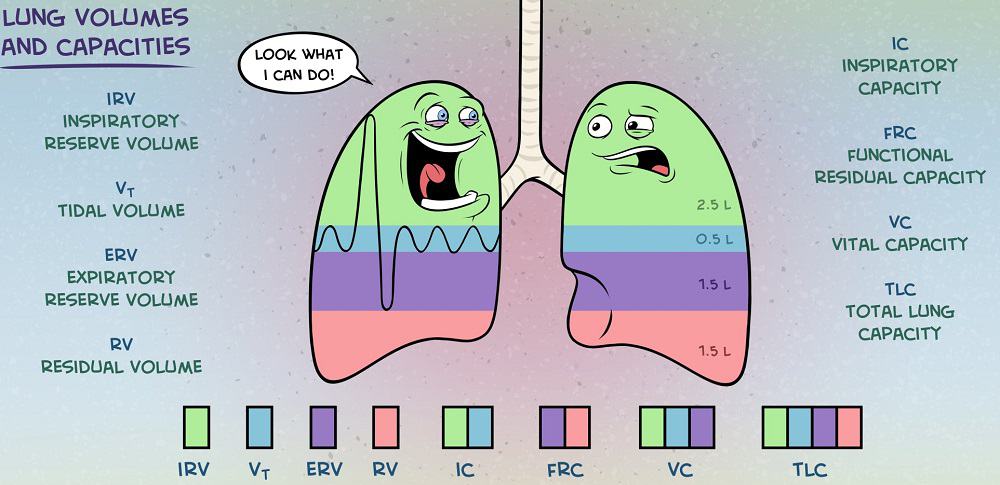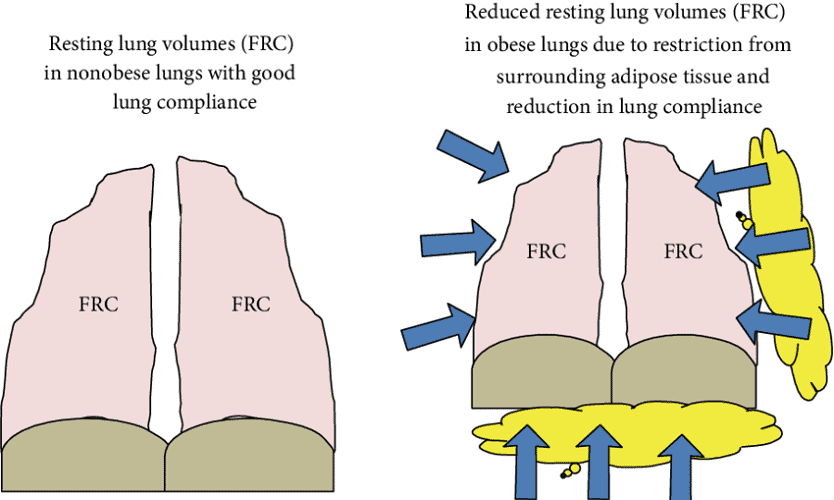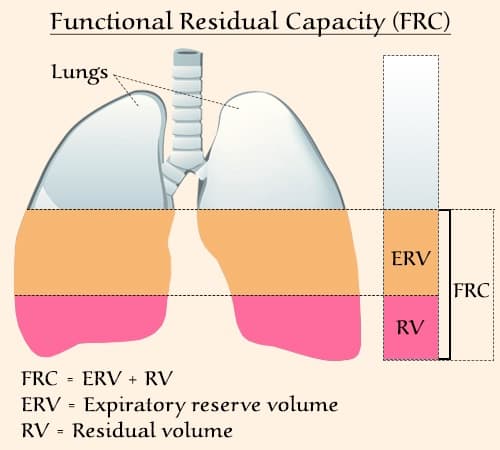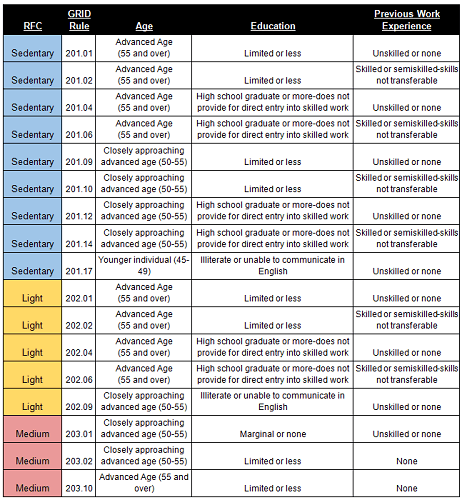We all breathe 24×7 but do you know there is a lot of mechanism going on in this respiratory cycle. Now respiratory cycle comprises of inhaling & exhale of oxygen in & out of the lungs respectively that we call 1 breathe.
So does that mean there is a phase during this respiratory cycle when there is no gas inside your lungs?
No, that is not the case, there is always some volume of gas present at a given time & that is referred to as Lung Volume. And the summation of these lung volumes gives rise to a term called Lung Capacity.

There are mainly four types of Lung Capacities, read
- Total Lung Capacity
- Inspiratory Capacity
- Vital Capacity
- Functional Residual Capacity
These Lung Capacities are essential to examine Pulmonary Function Test. In this article, we will be discussing Functional Residual Capacity (FRC).
Functional Residual Capacity Overview
As we discussed earlier, there is always some volume of gas inside the lungs at a given time, which means even after we exhale the air out, some gas is still there inside our lungs, which is nothing but Functional Residual Capacity.

Definition –
Functional Residual Capacity (FRC) is the summation of lung volumes at the end of a passive & normal exhalation or expiration of air out of the lungs.
It is at this point of the respiratory cycle when the elastic recoil of the lungs is in equilibrium with that of the chest walls & no respiratory muscle is exerting any force.
Now let’s discuss the Functional Residual Capacity in terms of Lung Volumes.
In terms of Lung Volume
As we discussed, lung capacities are the summation of lung volumes, the same is the case for Functional Residual Capacity. It is the sum total of two Lung volumes, namely,

- Residual Volume (RV) – After a maximal expiration of air, some volume still remains inside our lungs, which is referred to as residual volume. For a normal adult, the average value is 1200mL
- Expiratory Reserve Volume (ERV) – After the passive expiration of air, the volume that can still be exhaled forcefully is called Expiratory Reserve Volume. For a normal adult, the average value is 700mL-1200mL.
So, Functional Residual Capacity Equation is –
FRC = RV + ERV
Now considering this, what is the normal value of Functional Residual Capacity?
For a normal adult, the average FRC is 1800mL-2200mL.
In Terms Of Tidal Volume
There is a fixed amount of air that can be expired or inhaled in & out of the lungs & this amount is known as Tidal Volume. The normal value ranges from 300mL to 500mL.
If we talk in terms of Tidal Volume, Functional Residual Capacity is the amount of air in the lungs at the point where Tidal Volume is the lowest.
Note – Normal adult weight is considered as 70Kg here.
How IS FRC Calculated?
Functional Residual Capacity cannot be measured by Spirometry, which is a technique used to determine what volume of air is exhaled or inhaled by your lungs.
Now, what could be the reason to that?
Well, a simple answer to this question is that since FRC is the summation of Residual Volume & Expiratory Reserve Volume. As we explained, Residual Volume is the amount of air that cannot be exhaled out of the lungs & what cannot be exhaled cannot be measured by Spirometry.
Hence, two techniques that are used to calculate FRC are –
- Pulmonary Plethysmograph Method – This method is based on Boyle’s Law
- Helium Dilution Method – This method is based on the Law of Conservation of Mass.
Significance of Functional Residual Capacity
FRC is the point of equilibrium for chest & lungs tissues, and there are two types of diseases that leads to a disturbed Functional Residual Capacity –
- Restrictive diseases – Such diseases lead to a decrease in Total Lung Capacity (TLC) which further leads to a reduced Functional Residual Capacity that causes the lungs & chest walls to expand less.
Examples of such diseases are – Kyphosis (spinal disorder) & Idiopathic Pulmonary Fibrosis (Scarring of Lung Tissues) - Obstructive diseases – Such diseases cause destruction of alveoli & hence causing air to be trapped inside the lungs. This increases Total Lung Capacity & hence FRC increases as well. Such diseases are mostly related to the expansion of the chest, for example – Emphysema
Functions Of Functional Residual Capacity
Many factors are related to FRC & hence results in many functions –
- Airway Resistance – Airway resistance is highly dependent on FRC. As FRC decreases due to a reduction in Total Lung Capacity, the tension in alveoli, which pulls the airways in the lungs open, also reduces. Hence, airway resistance increases as a result of narrower airways.
- Work is done by breathing – At the point of FRC, the work done to dilate the lungs is lowest because of equilibrium.
- Vascular Resistance – The Vascular resistance is lowest at the point of FRC, which is denoted by the U-shaped graph, the highest points being the Total Lung Capacity & Residual Volume.
- Oxygen Reserve – At the point of FRC, the volume of air inside the lungs acts as an oxygen reserve that can be used for the exchange of oxygen & hence can be helpful during anesthesia.
- Closing Capacity – There is a certain threshold Functional Residual Capacity known as closing capacity & if the volume of gas inside the lungs reduces below that while passive exhale, there is a collapse in bronchioles leading to shunts.
Factors That Affect Functional Residual Capacity
There are various factors that affect the Functional Residual Capacity –
- Age
The FRC is inversely proportional to age, as with the increase in age, it becomes harder for the lungs to get back to normal size after inhalation. This happens because with age, there is a reduction in elasticity which makes the work of breathing harder & it becomes difficult for air to expel, reducing the FRC. - Position
The position plays a major role as FRC is the maximum when someone is upright, while it decreases if you are prone. The decrease in FRC is because, in prone position, the airways close in many regions of the lungs. - Gender
When it comes to gender, men & women tend to have different Functional Residual Capacity which is due to variation in Total Lung Capacity among the two. And this again boils down to the fact that men & women have very different structures. The ribcage is smaller for women where the inclination of the ribs is very different than men due to which the lung volume is more for men & hence more FRC. But due to the inclination of ribs, women tend to expand their chest more, which helps them during pregnancy physiological changes. - Height
Height too plays a major role as taller the person, larger is the lung volume & hence more is the Functional Residual Capacity. - Anesthesia
After the intake of anesthetics, the respiratory muscles relax & hence which affects the Functional Residual Capacity. - Pregnancy
In pregnant women also, the lung volumes change significantly nd this is due to the fact that in pregnancy, there is relaxation in the diaphragm due to which both Residual Volume & Expiratory Reserve Volume decreases and since FRC is the summation of two, it reduces as well. - Obesity
Obese people often face shortness of breath & the reason is related to Functional Residual Capacity. Due to obesity, the pressure on the diaphragm increases & thoracic volume decreases. Both these factors give rise to a reduced FRC. - Exercise
While the body is exerting during an exercise or increased intense activity, the tidal volume (TV) decreases & Respiratory frequency also surges. Due to this pattern, FRC reduces.
Residual Functional Capacity
This term, Residual Functional Capacity, is often confused with Functional Residual Capacity because of obvious reasons, but both are completely different from each other.
Let’s see what does this term actually means.
Ever heard of Social Security Administration Disability Benefits, well if not, before moving on to the explanation of RFC, you should be aware of the same.
Well, here, disability means any physical or physiological impairment that a person might suffer & due to this, certain monetary benefits are provided to the person suffering or his family by Social Security Administration.
Now to identify whether a person is eligible to get these benefits, Social Security Administration follows different criteria to assess whether the person is actually disabled to perform paid employment or not like medical records, doctor’s review, daily activities, effects of symptoms, etc.
One such method is assessing Residual Functional Capacity.
What Is Residual Functional Capacity?

Residual Functional capacity determines the maximum work an impaired person can do despite the fact that he is facing physical or mental restrictions due to the impairment.
It is basically used to evaluate whether or not you are able to do certain activities, mental or physical, even if you are facing any medical condition.
They are important to analyze whether you are able to perform at a workplace, & by perform we mean, physical, mental, sedentary, or other medium, light, heavy work.
How To Determine Residual Functional Capacity?
To determine Residual Functional Capacity, there are some techniques used by SSA:
- Review & Evaluation of disabilities by Disability Claims Examiner who eventually assesses using your doctor’s recommendation and medical records.
- Another way is to get it evaluated by a DDS physician that whether or not you have any limitations and if it is there, how it prevents you to meet the requirements at a workplace.
- Another convenient way is to get your RFC form filled by your doctor because who else is the best person to know about your medical condition & it is more trustworthy when it comes to getting approval by SSA.
Residual Functional Capacity Chart
Following is the Functional Residual Capacity Chart depicting how Residual Functional Capacity is determined for different activities.

Residual Functional Capacity Forms
As we already discussed, Residual Functional Capacity forms are filled in order to evaluate & assess the same by SSA.
You can easily download the Residual Functional Capacity form PDF from SSA official site.
Conclusion
Getting back to our main topic of discussion. Functional Residual Capacity is something not to be ignored as it is related to the occurrence of many diseases and, conversely, used to diagnose many pulmonary problems.
Also, as we discussed, FRC is dependent on many factors; some controllable, like position, obesity, etc. need to be taken care of in order to keep FRC at equilibrium as the disturbed one can have some adverse effects on your health.
